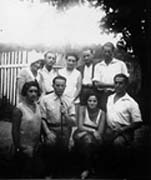
Poland, circa 1932. Photographer unknown.
©1996 from the Estate of David Seymour

Photograph of Chim by Elliot Erwitt
© 1996 Elliott Erwitt
|
Chim was born David Szymin on November 20, 1911, in Warsaw,
Poland, then a province of Czarist Russia. On becoming a photo-
reporter in Paris in 1933, he signed his work "CHIM," a French
phonetic abbreviation of his surname, distinctive in its use of capital
letters and elegant in its brevity. Life began for David and his sister,
Eileen, three years his senior, as the children of Regina and Benjamin
Szymin, a respected publisher of Yiddish and Hebrew books. They
enjoyed an excellent education in Jewish and secular subjects, with
David attending the Jewish Gymnasium Ascolah.
Upon passing his baccalaureate David also went off to Germany,
to Leipzig, to the Akademie der Graphischen und Buch Küenste
(Academy of Graphic and Book Arts), the finest school in the art of
book making. David specialized in new color printing techniques,
suitable for reproduction of paintings in books.
Photography would have an important role to play in the post-
World War I world, a world in which people had suffered and been
killed by the millions, and monarchies had given rise to republics.
Now, citizens of these new republics were to reap the rewards of
personal dignity and productivity.
This optimism and good will did not last long. Under the strain
of mass unemployment, new forms of autocracy and fascism soon
flourished. In 1929 when David arrived in Leipzig, German
unemployment stood at one million. Two years later, six times that
number were without work. In the 1932 national elections, Hitler's
National Socialists increased their seats in the Reichstag from seven
to twelve. By the time David graduated from the Academy of Graphic
and Book Arts, Germany was well on the road to National Socialism, in
a vortex of economic turmoil, and in increasing danger of major
political excesses.
Back in Poland, David found economic conditions stagnant and
fascist tendencies on the rise. He decided to move to Paris, to
complete his studies at the Sorbonne. When he arrived in Paris in the
fall of 1932, David had barely turned twenty-two. He had registered
at the Sorbonne as a student in advanced chemistry and physics and
had an allowance from home, but soon the economy in Poland
weakened and this affected his father's business. Not wanting to be a
burden to his family, David thought about supplementing his funds. A
Paris friend of the family, David Rappaport, owned a pioneer picture
agency "Rap," which supplied photographs to book publishers and to a
growing number of magazines and newspapers. He loaned David a
35mm camera and suggested he try his hand at taking pictures
suitable for production.
In November 1933, David wrote to his girlfriend, Emma, in
Warsaw:
Today it is one year since I came to Paris -- an important
anniversary that puts me in a mood for reflection and memories. As
you know, I am not any more working at reproduction (lithography).
I am a reporter, or more exactly, a photo-reporter... My stories
appeared lately in Paris Soir (about the Metro.) Regards will publish
my two big stories. Basically I am satisfied with myself, because I
am working well. I know what I want at this moment and I am
making progress in that direction. But I want to do something bigger.
Then, socially, I am moving in new circles, away from the Polish gang.
I am more among photographers, thinking people, interested in the
same problems as myself. We are trying to organize some kind of
association of revolutionary-minded people.
His two photographer friends are André Friedman, later to be
known as Robert Capa, and Henri Cartier-Bresson, bylined Henri
Cartier before the war. The first historic meetings of the triumvirate
that would become Magnum occurred in those heady and tumultuous
days when Paris was a fermenting ground of clashing ideologies.
- Inge Bondi
© 1996, Inge Bondi
from CHIM: The Photographs of David Seymour, Bulfinch Press/Little, Brown and Company
|





































